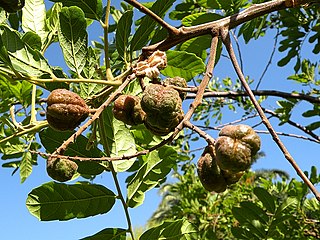
Botrytis cinerea is a necrotrophic fungus that affects many plant species, although its most notable hosts may be wine grapes. In viticulture, it is commonly known as "botrytis bunch rot"; in horticulture, it is usually called "grey mould" or "gray mold".

The Allgemeine Encyclopädie der Wissenschaften und Künste was a 19th-century German encyclopaedia published by Johann Samuel Ersch and Johann Gottfried Gruber, therefore also known as the "Ersch-Gruber." One of the most ambitious encyclopaedia projects ever, it remains uncompleted.

Juglans cinerea, commonly known as butternut or white walnut, is a species of walnut native to the eastern United States and southeast Canada.

Eduard Friedrich Poeppig was a German botanist, zoologist and explorer.

Tetrorchidium is a genus of flowering plants in the family Euphorbiaceae first described in 1841. It is native to tropical portions of Africa and the Western Hemisphere.

Salix cinerea is a species of willow native to Europe and western Asia.

Dalechampia dioscoreifolia is a species of plant in the family Euphorbiaceae first described in 1841. It is native to Central America and northern and western South America.

The big-eared brown bat is a species of vesper bat found in Argentina, Paraguay, and Chile.

Rhinella poeppigii is a species of toad in the family Bufonidae that is known from the eastern Andean slopes of Ecuador, Peru, and Bolivia, as well as from Serranía de Sira in Amazonian Peru. Its distinctiveness from Rhinella marina has been debated, but it is currently accepted as a valid species. It is named after Eduard Friedrich Poeppig, German botanist and naturalist who made scientific expeditions to South America.

Cyclanthus a genus of plants in the family Cyclanthaceae, first described as a genus in 1824. It is native to tropical Latin America and the West Indies. It consists of large, palm-like monocots.

Cyclanthus bipartitus a species of plant in the family Cyclanthaceae, first described as a genus in 1824. It is native to southern Mexico, Central America, Trinidad, Windward Islands, northern South America.

Comparettia, abbreviated Comp in the horticultural trade, is a genus of orchids. It consists about 50-70 species, native to tropical America. They occur in Mexico, Central America, the West Indies, and in northern South America as far south as Brazil and Bolivia, although they are particularly common in the Andes. The genus has grown markedly in recent years due to many species being transferred from other genera.

Botrydial is secondary metabolite secreted by the fungus Botrytis cinerea which is phytotoxic. Chemically it is a sesquiterpene. Botrydial was first isolated and described in 1974. B. cinerea is the causal agent of gray mold disease and is known to attack a wide range of plants producing leaf-spot diseases and mildews on lettuces and tomatoes as well as rotting berries. For this reason, botrydial, as well as other B. cinerea originated sesquiterpene metabolites, represent an economically important disease for ornamental and agriculturally important crops. From all the metabolites produced by this fungus, Botrydial exhibits the highest phytotoxic activity.

Epidendrum compressum is a species of orchid in the genus Epidendrum from wet montane forests of Trinidad, Venezuela, Colombia, Ecuador, Peru and Bolivia.

Paranephelius is a genus of South American plants in the tribe Liabeae within the family Asteraceae.

Cupania is a plant genus in the family Sapindaceae.

Geogenanthus poeppigii, commonly called the seersucker plant, is a flowering plant species in the family Commelinaceae. As currently circumscribed, the genus Geogenanthus includes two other species, G. ciliatus and G. rhizanthus. This species is named after 19th century German naturalist Eduard Friedrich Poeppig. Geogenanthus undatus is an outdated synonym for G. poeppigii.

Camaridium vestitum, called purple tiger orchid, is a species of epiphytic orchids native to Florida, the West Indies and through Latin America from Mexico to Bolivia.
Oriastrum is a genus of plants in the sunflower family, found only in the Republic of Chile in South America.
Xiphochaeta is a genus of South American plants in the tribe Vernonieae within the family Asteraceae.
















